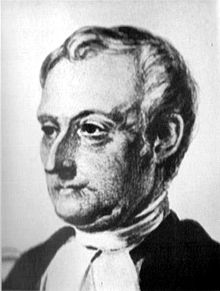William Broughton (bishop)

William Grant Broughton (22 May 1788 – 20 February 1853) was the first (and only) Bishop of Australia of the Church of England. (The diocese was later restructured into many smaller sees.)
Broughton was born at Westminster and educated well for his day, including at The King's School, Canterbury, where he was a King's scholar. His fortunes turned from commerce to theology when he inherited a substantial sum, allowing him to study at Pembroke College, Cambridge. He graduated B.A. as 6th wrangler in 1818,[1] and was also in that year ordained deacon and priest and married to Sarah Francis. He graduated M.A. in 1823. He first became a curate in Hampshire, then later in Surrey where he became noticed by the Duke of Wellington who materially assisted his prospects, including certain influence in Broughton being offered the Archdeaconry of Sydney.
Broughton arrived in Sydney on 13 September 1829, succeeding Thomas Scott as Archdeacon of New South Wales (that at the time substantially encompassed what is now the states of New South Wales plus Queensland to the north and Victoria to the south.) At this time, the colony was ecclesiastically an Archdeaconry of the Diocese of the Bishop of Calcutta.
Broughton was promptly made a member of both the colony's legislative council and executive council, assisting the Governor in the administration. He was also in charge of the commission for the overall policy towards Tasmanian natives, commission who continued the current policy of bounties and roving parties[2]. He was granted a leave of absence and returned to England in 1834, there championing the cause of the church. The result was not as he expected; the diocese of Australia was to be formed. He was enthroned Bishop of Australia on 5 June 1836 in St James' Church, Sydney, as ruler of the new diocese of Australia just days after his arrival from England.[3]
Broughton had a controversy with Charles Beaumont Howard over Howard's jurisdiction in South Australia. Broughton was a busy bishop, and travelled widely, perhaps more so after his wife died in 1848.
Broughton travelled to England in late 1852 and was involved in administration and missionary fund raising. Broughton died in London in February 1853, and is buried in Canterbury Cathedral.
Legacy


In 1842 the Diocese of Tasmania was created; in 1847 the Diocese was divided further to form the four Dioceses of Sydney (which Broughton retained), Adelaide, Newcastle and Melbourne.
He is widely accepted as the founder of the King's School at Parramatta, then a town at a distance of a day's ride from Sydney.
Broughton made many journeys around the fledgling colony and is credited as instigating the building of many churches in places such as Newcastle and the Hunter Valley north of Sydney and in the Monaro region inland to the south-west.
Broughton championed the Newcastle case, and forfeited 500 pounds sterling from his salary to partly fund the development of a new diocese.
St. Andrew's Cathedral, Sydney, was commenced during the late 1840s.
On 12 March 1845 he consecrated St John the Baptist Church at what later became the site of the federal capital of Australia, Canberra.
His portrait, by Marshall Claxton, is at St. Paul's College, Sydney.
The Broughton River and Port Broughton in South Australia are both named after him.
Broughton also consecrated Saint Mary on Allyn, Allynbrooke, in the Hunter Valley. His son-in-law, William Barker Boydell, married his daughter Mary Phoebe and the Broughton ordered that a church be built for his daughter to worship in. William Boydell and Mary Phoebe are both buried at Saint Mary on Allyn, along with their son, Henry, who died when he was one year old.
Broughton is commemorated in the Australian Anglican calendar on 20 February.
See also
References
- ^ "Broughton, William Grant (BRTN814WG)". A Cambridge Alumni Database. University of Cambridge.
- ^ Diamond, Jared (1991). The rise and fall of the third chimpanzee. London: Vintage Random House. p. 252. ISBN 978-0-099-91380-1.
- ^ Cable, Kenneth (1999). St James' 1824-1999. Sydney: Churchwardens of St James Church. p. 5. ISBN 0-646-37719-1.
{{cite book}}: Unknown parameter|coauthors=ignored (|author=suggested) (help)
External links
- K. J. Cable, 'Broughton, William Grant (1788 - 1853)', Australian Dictionary of Biography, Volume 1, Melbourne University Press, 1966, pp 158–164.
- Bibliographic directory on Broughton from Project Canterbury
- Henry Bailey, Bishop Broughton of Australia (1891)
- Christ Church Cathedral, Newcastle - History
- Christ Church - Cooma, Monaro district
- 1850 - Parish of Albury, New South Wales
- Heraldic legacy - stars in Crest of the Bishop to the Australian Defence Force
- Serle, Percival (1949). "Broughton, William Grant". Dictionary of Australian Biography. Sydney: Angus & Robertson.
